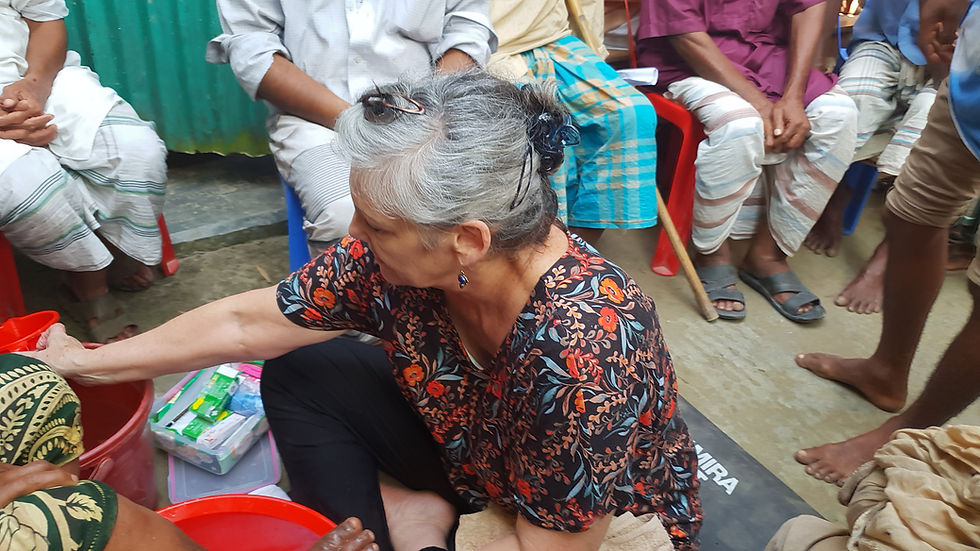Lymphoedema in Rural Bangladesh
- Oct 25, 2018
- 4 min read
Updated: Feb 7
My main role at the Centre for Neglected Tropical Diseases #CNTD - so far - has been to design and implement a study to see if we can improve on self-management for people affected by moderate to severe #LymphaticFilariasis and #Podoconiosis related #lymphoedema. And after almost a year of planning we started data-collection in Nilphamari District in north west Bangladesh at the beginning of October.

Back at the beginning of my PhD research I conducted a systematic review on self-management for lymphoedema, which mostly compared the different approaches between breast cancer-related lymphoedema (BCRL) and filarial lymphoedema. To summarise my findings in one sentence, BCRL is dependent on individual therapist treatments to reduce existing oedema followed by education in self-care to halt progression, while people affected by filarial lymphoedema receive group instruction in simple hygiene routines aimed at reducing the frequency of secondary bacterial infections and to halt lymphoedema progression. My main conclusion regarding self-care for filarial lymphoedema was to provide education in self-treatments that can reduce existing oedema, not just prevent infections.

Fast forward a few years - including almost a year of planning, budgets, ethics applications and amendments, and assembling in-country support teams - and we are ready to start baseline data collection in Bangladesh. Firstly we had several training sessions in Dhaka for the data collectors who will take all the measurements in the field. Then it was into a van with all the equipment and the wash kits that will be issued to the study participants and off to Nilphamari.


After checking into the Dutch Bangladesh Leprosy Hospital Guest House, we set up office in the lounge area and organised all the equipment ready for our first day of data collection.

We have two data collection teams and each day we visit one community per team. The Community Clinics (CC) are located on land that has usually been donated by a local landowner, and the clinic itself is owned by the people. One or two health workers are employed by the Ministry of Health and Family Welfare (MOHFW) to attend to the health needs of the people including maternal and infant health and dispensing of medications such as pain medication, topical creams and oral antibiotics. Serious illness or injuries are referred to the District Hospital. Each CC caters for around 5000 people, mainly farming and village dwelling families.

At each CC we invited all the people already on the lymphoedema register to attend an information session about the study. We are interested to see if our additional lymphoedema-care activities can help those with more advanced disease, so people who had mild stage disease (swelling that reverses with elevation or mild swelling without any skin changes) were not enrolled, but were invited to stay for the education in lymphoedema management.

Each patient had to have a dedicated care-giver to be enrolled in the study with them. As we were targeting people with more advanced lymphoedema, we wanted to be sure that everyone had someone to call on for help if they needed it.

After providing information about the study and what we will ask them to do, each person has to give informed consent in order to be included.

We then took all our baseline measures and administered some quality of life questionnaires, so we will be able to tell if our program has subjective benefits as well as improving lymphoedema status.



Half of the CC’s were randomly allocated to the standard- care group, that is the hygiene centred routine that is recommended by WHO under the Global Program to Eliminate LF (GPELF).

The other half of the CC’s were allocated to what we are calling the enhanced-care group.
Their routine includes all the hygiene centred activities of the standard-care group with the addition of deep breathing, additional leg exercise including walking more, a self-massage routine as well as some recommendations about drinking enough water and eating fresh fruit and vegetables to boost immune activity.

The participants will record what they do in a daily journal.

Participants are given the wash kits and journals to take home. We will come back to assess how they are going twice more over the next few months and then at the end of the 6 months study.

Not all the CC are accessible by road and some days we had to carry our equipment part of the way.

Over the next few months I’ll post more photos of our project in Bangladesh and in November we will start the same study in Ethiopia.
.png)
Comments